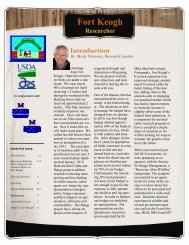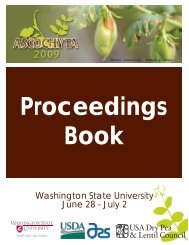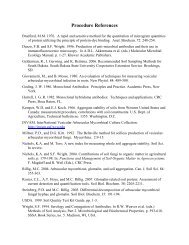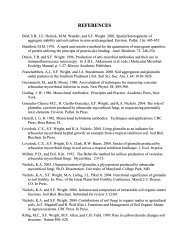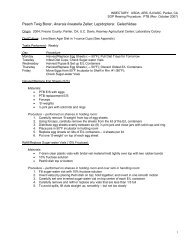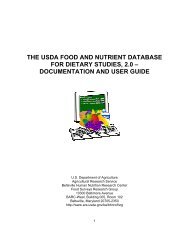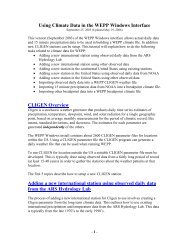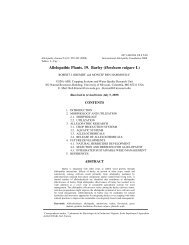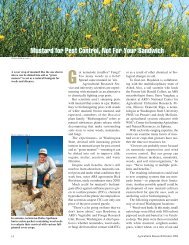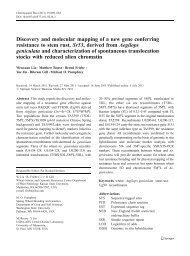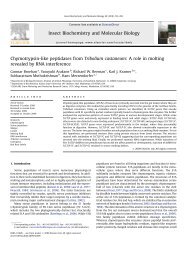International Journal of Poisonous Plant Research - Agricultural ...
International Journal of Poisonous Plant Research - Agricultural ...
International Journal of Poisonous Plant Research - Agricultural ...
Create successful ePaper yourself
Turn your PDF publications into a flip-book with our unique Google optimized e-Paper software.
Clinical and Pathological Aspects and Cerebellar Lectin<br />
Binding in Cattle Poisoned With Solanum fastigiatum var.<br />
fastigiatum and Solanum bonariense<br />
Fabiano J.F. Sant’Ana 1 , Claudio G. Barbeito 2 , Fabian Nishida 2 , Eduardo J. Gimeno 2 , José<br />
M. Verdes 3 , Daniel Battes 3 , Antonio Moraña 3 , and Claudio S.L. Barros 1<br />
1<br />
Federal University <strong>of</strong> Santa Maria, Laboratory <strong>of</strong> Veterinary Pathology, Santa Maria,<br />
RS, Brazil<br />
2<br />
National University <strong>of</strong> La Plata, Faculty <strong>of</strong> Veterinary Science, La Plata, Argentina<br />
3<br />
University <strong>of</strong> the Republic, Faculty <strong>of</strong> Veterinary Science, Montevideo, Uruguay<br />
Corresponding author: Claudio S.L. Barros, claudioslbarros@uol.com.br<br />
Abstract<br />
Microscopic and lectin histochemical studies were performed using the cerebella <strong>of</strong> 33<br />
natural cases <strong>of</strong> Solanum fastigiatum var. fastigiatum intoxication in cattle from southern<br />
Brazil and 2 natural and 4 experimental cases <strong>of</strong> Solanum bonariense from Uruguay. The<br />
following biotinylated lectins were used in both cases: WGA, sWGA, BS-I, Con-A,<br />
RCA-I, DBA, and UEA-I, with the addition <strong>of</strong> LCA in S. fastigiatum poisoning cases.<br />
Histologically, the lesions consisted <strong>of</strong> fine vacuolization, distention <strong>of</strong> portions <strong>of</strong> the<br />
Purkinje cells, axonal spheroids measuring 14-50 µm in the granular cell layer and<br />
adjacent white matter and, proliferation <strong>of</strong> the Bergmann’s glia. Lectin histochemistry<br />
revealed strong reactivity <strong>of</strong> stored material in Purkinje neurons with the lectins sWGA,<br />
Con-A, and LCA in S. fastigiatum cases. A similar pattern was found in S. bonariense<br />
cases with a most intense reaction to WGA, and less intense reaction to Con-A, whereas<br />
BS-I and RCA-I binding was absent to poor in these neurons in all the cases studied.<br />
Lectin reactivity in Purkinje cells between cases was independent <strong>of</strong> cell damage (from<br />
mild to severe loss <strong>of</strong> neurons). Both S. fastigiatum and S. bonariense have similar lectin<br />
binding, suggesting a similar pathogenesis. Since comparable binding patterns have been<br />
described in animals poisoned with swainsonine-containing plants, perhaps the toxins in<br />
these plants contain related glycosidase-inhibiting toxins or inhibit glycoprotein and<br />
lysosomal metabolism through some related mechanism. The results <strong>of</strong> this study showed<br />
that in spontaneous poisoning by S. fastigiatum and S. bonariense in cattle, the pattern <strong>of</strong><br />
lectin binding is similar to those observed in S. fastigiatum experimental conditions.<br />
Keywords: Cattle, cerebellar degeneration, lectin histochemistry, neurotoxicity, poisoning,<br />
Solanum fastigiatum, S. bonariense<br />
Introduction<br />
Solanum fastigiatum var. fastigiatum and S.<br />
bonariense intoxication is an important cerebellar<br />
disorder in cattle in southern Brazil and Uruguay<br />
28<br />
(Riet-Correa et al. 1983, Rech et al. 2006, Verdes et<br />
al. 2006). S. fastigiatum is one <strong>of</strong> the major plant<br />
poisonings in cattle in Rio Grande do Sul, a state in



